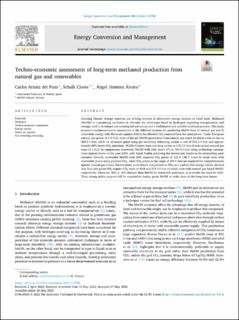| dc.contributor.author | Arnaiz del Pozo, Carlos | |
| dc.contributor.author | Cloete, Schalk Willem Petrus | |
| dc.contributor.author | Jiménez Álvaro, Ángel | |
| dc.date.accessioned | 2022-10-26T12:46:26Z | |
| dc.date.available | 2022-10-26T12:46:26Z | |
| dc.date.created | 2022-09-07T13:25:16Z | |
| dc.date.issued | 2022 | |
| dc.identifier.citation | Energy Conversion and Management. 2022, 266 1-17. | en_US |
| dc.identifier.issn | 0196-8904 | |
| dc.identifier.uri | https://hdl.handle.net/11250/3028457 | |
| dc.description.abstract | Growing climate change concerns are driving interest in alternative energy carriers to fossil fuels. Methanol (MeOH) is a promising candidate to alleviate the challenges faced by hydrogen regarding transportation and storage, with a developed pre-existing infrastructure and a well-known and scalable synthesis process. This study presents a techno-economic assessment of the different avenues for producing MeOH from 1) natural gas and 2) renewable energy with direct air capture (DAC), for effective CO2 removal from the atmosphere. Under European natural gas prices (6.5 €/GJ), state-of-the-art MeOH production from natural gas reach levelized costs as low as 268.5 €/ton, while an advanced plant using gas switching reforming attains a cost of 252.2 €/ton and approximately 60% lower CO2 emissions. Middle Eastern costs can drop as low as 135.2 €/ton thanks to low natural gas costs (2 €/GJ). In comparison, renewable MeOH with DAC reach 471.6–784.9 €/ton using technology assumptions representative of the year 2050, with Saudi Arabia achieving the lowest cost thanks to its outstanding solar resource. Overall, renewable MeOH with DAC required CO2 prices of 121.4–146.7 €/ton to break even with renewable plants using pipeline CO2, while CO2 prices in the range of 300 €/ton are required for competitiveness against natural gas routes. Furthermore, a consistent comparison to NH3 as a carbon-free energy carrier showed that blue and green NH3 require CO2 taxes of 49.8 and 274.3 €/ton to break even with natural gas-based MeOH, respectively. However, NH3 is 14% cheaper than MeOH for renewable pathways, as it avoids the need for DAC. Thus, strong policy support will be required to deploy green MeOH at scale, even in the long-term future. | en_US |
| dc.language.iso | eng | en_US |
| dc.publisher | Elsevier | en_US |
| dc.rights | Navngivelse 4.0 Internasjonal | * |
| dc.rights.uri | http://creativecommons.org/licenses/by/4.0/deed.no | * |
| dc.subject | Gas switching reforming | en_US |
| dc.subject | Direct air capture | en_US |
| dc.subject | Energy carrier | en_US |
| dc.subject | Techno-economic assessment | en_US |
| dc.subject | Methanol | en_US |
| dc.title | Techno-economic assessment of long-term methanol production from natural gas and renewables | en_US |
| dc.title.alternative | Techno-economic assessment of long-term methanol production from natural gas and renewables | en_US |
| dc.type | Peer reviewed | en_US |
| dc.type | Journal article | en_US |
| dc.description.version | publishedVersion | en_US |
| dc.rights.holder | © 2022 The Author(s). Published by Elsevier Ltd. | en_US |
| dc.source.pagenumber | 1-17 | en_US |
| dc.source.volume | 266 | en_US |
| dc.source.journal | Energy Conversion and Management | en_US |
| dc.identifier.doi | 10.1016/j.enconman.2022.115785 | |
| dc.identifier.cristin | 2049492 | |
| cristin.ispublished | true | |
| cristin.fulltext | original | |
| cristin.qualitycode | 1 | |

